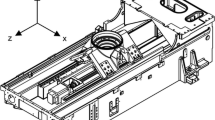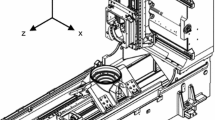Abstract
In recent times, simulation techniques have been rapidly accepted by the machine tool industry. However, most existing simulation studies have focused on a particular machine tool and described an entire machine tool feed drive as a single combined system. This paper presents a method to accurately predict motor current (torque) behavior and acquire a more generalized and accurate dynamic simulation model for a machine tool feed drive. To improve the generality, a component-based approach is introduced. In this approach, the feed drive model is composed of subcomponent models, and each component mechanism is then independently modeled. In the developed model structure, the parameters of the subcomponent model can easily be determined by using product datasheets or simple parameter identification based on motor current measurements. To enhance the model accuracy in predicting the motor current, an improved friction model including time-dependent frictional characteristics and rolling contact conditions was introduced to the simulation. The performance of the developed dynamic simulation model is demonstrated through a comparison with real machine tool behavior.
Similar content being viewed by others
References
Park, H.-S. and Choi, H.-W., “Development of a Modular Structure-based Changeable Manufacturing System with High Adaptability,” Int. J. Precis. Eng. Manuf., Vol. 9, No. 3, pp. 7–12, 2008.
Reinhart, G. and Weissenberger, M., “Multibody Simulation of Machine Tools as Mechatronic Systems for Optimization of Motion Dynamics in the Design Process,” Proceedings of the 1999 IEEE/ASME International Conference on Advanced Intelligent Mechatronics, pp. 605–610, 1999.
Younkin, G. W., “Modeling Machine Tool Feed Servo Drives Using Simulation Techniques to Predict Performance,” IEEE Transactions on Industry Applications, Vol. 27, No. 2, pp. 268–274, 1991.
Ebrahimi, M. and Whalley, R., “Analysis, Modeling and Simulation of Stiffness in Machine Tool Drives,” Computers & Industrial Engineering, Vol. 38, No. 1, pp. 93–105, 2000.
Cheok, K. C., Hu, H. and Loh, N. K., “Modeling and Identification of a Class of Servomechanism Systems with Stick-Slip Friction,” Journal of Dynamic Systems, Measurement, and Control, Vol. 110, No. 3, pp. 324–328, 1988.
Pan, Y.-R., Shih, Y.-T., Horng, R.-H. and Lee, A.-C., “Advanced Parameter Identification for a Linear-Motor-Driven Motion System Using Disturbance Observer,” Int. J. Precis. Eng. Manuf., Vol. 10, No. 4, pp. 35–48, 2009.
Feng, L., Bin, L. and Xiaofeng, Z., “Numerical Design Method for Water-Lubricated Hybrid Sliding Bearings,” Int. J. Precis. Eng. Manuf., Vol. 9, No. 1, pp. 47–50, 2008.
Erkorkmaz, K. and Altintas, Y., “High Speed CNC System Design. Part II: Modeling and Identification of Feed Drives,” International Journal of Machine Tools & Manufacture, Vol. 41, No. 10, pp. 1487–1509, 2001.
Erkorkmaz, K., Altintas, Y. and Yeung, C.-H., “Virtual Computer Numerical Control System,” CIRP Annals-Manufacturing Technology, Vol. 55, No. 1, pp. 399–402, 2006.
Mei, X., Tsutsumi, M., Yamazaki, T. and Sun, N., “Study of the Friction Error for a High-Speed High Precision Table,” International Journal of Machine Tools & Manufacture, Vol. 41, No. 10, pp. 1405–1415, 2001.
Kim, M.-S. and Chung, S.-C., “Friction identification of ball-screw driven servomechanisms through the limit cycle analysis,” Mechatronics, Vol. 16, No. 2, pp. 131–140, 2006.
Bescancon-Voda, A. and Besancon, G., “Analysis of a two relay system configuration with application to Coulomb friction identification,” Automatica, Vol. 35, No. 8, pp. 1391–1399, 1999.
Tan, K. K., Lee, T. H., Huang, S. N. and Jiang, X., “Friction modeling and adaptive compensation using a relay feedback approach,” IEEE Transactions on Industrial Electronics, Vol. 48, No. 1, pp. 169–176, 2001.
Isermann, R., “Fault Diagnosis of Machines via Parameter Estimation and Knowledge Processing-Tutorial Paper,” Automatica, Vol. 29, No. 4, pp. 815–835, 1993.
Jeong, Y. H. and Cho, D.-W., “Estimating Cutting Force from Rotating and Stationary Feed Motor Currents on a Milling Machine,” International Journal of Machine Tools and Manufacture, Vol. 42, No. 14, pp. 1559–1566, 2002.
Jönsson, A., Wall, J. and Broman, G., “A virtual machine concept for real-time simulation of machine tool dynamics,” International Journal of Machine Tools & Manufacture, Vol. 45, No. 7–8, pp. 795–801, 2005.
Pritschow, G. and Röck, S., “Hardware in the Loop Simulation of Machine Tools,” CIRP Annals-Manufacturing Technology, Vol. 53, No. 1, pp. 295–298, 2004.
Kim, M.-S. and Chung, S.-C., “Integrated design of high-speed feed drive systems,” Transactions of the KSME A, Vol. 27, No. 12, pp. 2028–2038, 2003.
Armstrong-Helouvry, B., Dupont, P. and Canudas De Wit, C., “A Survey of Models, Analysis Tools and Compensation Methods for the Control of Machines with Friction,” Automatica, Vol. 30, No. 7, pp. 1083–1138, 1994.
Karnopp, D., “Computer simulation of stick-slip friction in mechanical dynamic system,” Journal of Dynamic Systems, Measurement, and Control, Vol. 107, No. 1, pp. 100–103, 1985.
Bo, L. C. and Pavelescu, D., “The Friction-Speed Relation and Its Influence on the Critical Velocity of Stick-Slip Motion,” Wear, Vol. 82, No. 3, pp. 277–289, 1982.
THK Co. LTD., “LM System General Catalog (No.300-E),” 2001.
Tanaka, T., Ikeda, K., Otsuka, J., Masuda, I. and Oiwa, T., “Influence of Rolling Friction in Linear Ball Guideways on Positioning Accuracy,” Int. J. Precis. Eng. Manuf., Vol. 8, No. 2, pp. 85–89, 2007.
Rice, J. R. and Ruina, A. L., “Stability of Steady Frictional Slipping,” Journal of Applied Mechanics, Vol. 50, No. 2, pp. 343–349, 1983.
Walrath, C. D., “Adaptive Bearing Friction Compensation Based on Recent Knowledge of Dynamic Friction,” Automatica, Vol. 20, No. 6, pp. 717–727, 1984.
Hess, D. P. and Soom, A., “Friction at a Lubricated Line Contact Operating at Oscillating Sliding Velocities,” Journal of Tribology, Vol. 112, No. 1, pp. 147–152, 1990.
Jeong, Y. H., Min, B.-K. and Cho, D.-W., “Estimation of Machine Tool Feed Drive Inclination from Current Measurement and a Mathematical Model,” International Journal of Machine Tools and Manufacture, Vol. 46, No. 12–13, pp. 1343–1349, 2006.
FANUC Ltd., “FANUC AC Servo Amplifier Maintenance Manual (B-65005E),” 1992.
Lee, Y.-J., Yoon, Y.-J., Kim, Y.-H. and Lee, M.-H., “A Study on the Sensorless PMSM Control using the Superposition Theory,” International Journal of the Korean Society of Precision Engineering, Vol. 4, No. 2, pp. 5–12, 2003.
Nelles, O., “Nonlinear System Identification,” Springer-Verlag, pp. 105–107, 1988.
Hwang, Y.-K., Lee, C.-M. and Park, S.-H., “Evaluation of Machinability According to the Changes in Machine Tools and Cooling Lubrication Environments and Optimization of Cutting Conditions Using Taguchi Method,” Int. J. Precis. Eng. Manuf., Vol. 10, No. 3, pp. 65–73, 2009.
Horning, S., Keyhani, A. and Kamwa, I., “On-line Evaluation of a Round Rotor Synchronous Machine Parameter Set Estimated from Standstill Time-Domain Data,” IEEE Transactions on Energy Conversion, Vol. 12, No. 4, pp. 289–296, 1997.
Jablonski, R., Turlowski, M. and Szewczyk, R. (Eds), “Recent Advances in Mechatronics,” Springer, Berlin Heidelberg, pp. 178–184, 2007.
Saab, S. S. and Kaed-Bey, R. A., “Parameter Identification of a DC Motor: An Experimental Approach,” Proc. of the 8thIEEE International Conference on Electronics, Circuits and Systems, Vol. 2, pp. 981–984, 2002.
Toliyat, H. A., Levi, E. and Raina, M., “A Review of RFO Induction Motor Parameter Estimation Techniques,” IEEE Transactions on Energy Conversion, Vol. 18, No. 3, pp. 271–283, 2003.
Koubaa, Y., “Recursive identification of induction motor parameters,” Simulation Modeling Practice and Theory, Vol. 12, No. 5, pp. 363–381, 2004.
Shigley, J. E. and Mischke, C. R., “Mechanical Engineering Design, 6th ed.,” McGraw-Hill, pp. 450–457, 2001.
Author information
Authors and Affiliations
Corresponding author
Rights and permissions
About this article
Cite this article
Jeong, Y.H., Min, BK., Cho, DW. et al. Motor current prediction of a machine tool feed drive using a component-based simulation model. Int. J. Precis. Eng. Manuf. 11, 597–606 (2010). https://doi.org/10.1007/s12541-010-0069-1
Received:
Accepted:
Published:
Issue Date:
DOI: https://doi.org/10.1007/s12541-010-0069-1




